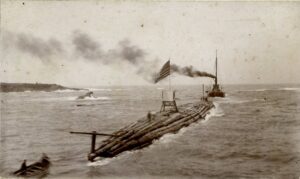This column is a further exploration into the history of log rafts on the Mendocino Coast and the topic will continue for the next few weeks. When a historian finds all kinds of interesting historical facts while researching, and it just won’t fit in one story, the topic becomes a series.

So why assemble a raft of logs and pull it 1,000 miles to a lumber mill in Southern California? If you have perfectly good sawmills from Mendocino Country north to Canada why not just turn logs to lumber near shipping points and send it off to market? The simple answer is SUNSHINE! Fresh cut lumber is wet and heavy. Heavy things are expensive to ship. In some manner, like stacking fresh lumber in sunshine, or placing it in a dry kiln indoors, boards need to season and dry out. Lighter boards are easier to ship and are ready to use. The Mendocino Headlands on the south side of Main Street, from the bridge across Big River to the shipping point, was stacked high with drying lumber for decades.
Loggers had figured out long ago that rolling logs into a river and letting the current carry the log to the sawmill saved time, energy, and money. All over the world there are traditions of river drives, if terrain allows. Finland, southwest Germany, Spanish Catalonia, the Netherlands, and Canada all did this, as did Michigan, Connecticut, Oregon, Maine, Idaho, and areas along the Mississippi River. Here, Big River log drives were famous for careful planning, removable dams, and high water to float logs 30 miles from the back-country timberlands down to the mill.
What’s a River Pig? It was the term given to the trained teams of men who worked a river drive. The experienced men formed the Jam Crew that broke up log jams and kept everything moving downstream and the newcomers formed the Rear Crew that pushed straggling logs back into the flow of water.
So, up in Oregon timber baron Simon Benson hired a raft building specialist to pursue an idea that had been experimented with for a while – let’s transport large quantities of timber from the Pacific Northwest and Canada to Southern California through open ocean. Hundreds of logs would be tied together in a wooden cradle-like skeleton (think of a sailing ship hull) and float it behind a tugboat to the sunny southland 1,000 miles away. The lumber was then milled at a San Diego sawmill on the waterfront, a location just south of the current convention center, and dried quickly in the sunshine.
It is likely that this lumber contributed to the building boom in that area in the early years of the 20th Century. Construction was said to have doubled with the arrival of cheaper lumber as a big log raft had enough lumber in it to build 450 homes and Benson sent several rafts down every summer. He also sent 100’ long logs to be used as pilings for waterfront development.
The first Benson Raft, launched in 1906 on the Columbia River near Astoria, was to be pulled by a steam tugboat, and took a month to assemble. Seven hundred to 1,000’ long, 55’ wide and 35’ top to bottom it was like floating an acre of land downstream. Just the chains alone weighed 125 tons as they held the cigar-shaped raft together. Often the rafts were deck-loaded with fence posts, telephone poles and shingles atop the logs. The whole goal was saving transportation coast. Benson sent 120 rafts south over 35 years.
So, locally the Fort Bragg Lumber Company had started experimenting with the idea as far back as 1892. The first raft, with thousands of board feet of potential lumber, held together with chains as thick as a man’s wrist, was pulled out of Noyo Harbor, hit a rock, and broke in half. Clean-up followed as loose logs hindered maritime traffic.
Try again! Later that year a new raft 326’ long, 34’ wide and 24’ deep was launched and made it to its destination of San Francisco, but the next raft broke up at sea. Log rafting ceased here but the lumber companies watched what Benson was doing. Kelley House docent Tonia Hurst wrote two excellent columns in the Beacon’s January 5 and 12, 2017 editions about local raft building attempts.
In 1914 Humboldt Bay timber baron A. B. Hammond decided he was going to build the biggest raft ever. With 60’ width, 835’ long and 11 million board feet of potential lumber, the raft had wood for 1,000 homes. It took six days to make the trip to San Francisco.
Simon Benson left an odd footnote in history…he became a ghost! In downtown Portland he built a fine 287 room hotel along the Willamette River, now a historic landmark and lovingly restored. Benson was a philanthropist and contributed towards the betterment of Portland. His ghost is reported to have been seen more than once on the seventh, ninth and twelfth floors of the hotel, well-groomed and dressed in a formal suit.
Coming up in future weeks will be a disastrous log raft accident and a log raft mystery.